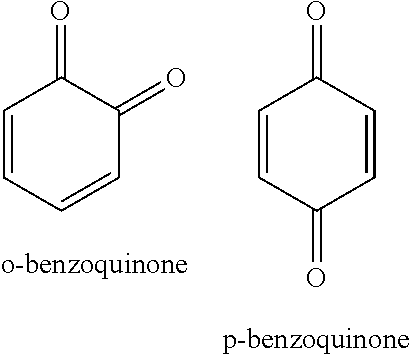Radiation-curable vinyl chloride resin composition and magnetic recording medium using the same
a technology of vinyl chloride resin and composition, which is applied in the direction of magnetic materials for record carriers, instruments, record information storage, etc., can solve the problems of reducing the curability of irradiation, the stability of coating liquid may be markedly reduced, and the stability of vinyl chloride binders is generally poor stability, so as to achieve good storage stability and curability
- Summary
- Abstract
- Description
- Claims
- Application Information
AI Technical Summary
Benefits of technology
Problems solved by technology
Method used
Image
Examples
example 1
[0155]To a two-liter flask was charged 416 g (124.8 g solid portion) of 30 percent cyclohexanone solution of sulfonate group-containing vinyl chloride copolymer (MR-104 from Zeon Corporation) and the mixture was stirred at a stirring rate of 210 rpm. Next, 0.5 g (4.464 mmol) of 1,4-benzoquione was added and dissolved by stirring.
[0156]Next, 0.125 g of dibutyltin laurate was added as a reaction catalyst and the mixture was heated to 40 to 50° C. with stirring. Subsequently, a radiation-curable functional group-incorporating component in the form of 13.75 g (0.09 mmol) of 2-methacryloyloxyethyl isocyanate (MOI made by Showa Denko) was added dropwise over 30 minutes. When the dropwise addition had been completed, the mixture was stirred for two hours at 40° C. and cooled to room temperature, yielding a resin solution containing radiation-curable function group (methacryloyloxy group)-containing vinyl chloride copolymer. 1H NMR data and its assignments are given below for the above radi...
example 2
[0159]With the exception that the MOI made by Showa Denko was replaced with 2-acryloyloxyethyl isocyanate (AOI made by Showa Denko) as the radiation-curable functional group-incorporating component, and 50 ppm of 4-hydroxy-2,2,6,6-tetramethylpiperidine-N-oxyl was added to the radiation-curable functional group-containing vinyl chloride copolymer following the reaction introducing the radiation-curable functional group, a resin solution (solid component 31.3 percent) of radiation-curable functional group-containing vinyl chloride copolymer was obtained by the same method as in Example 1. The same results as in Example 1 were obtained when NMR analysis, average molecular weight measurement, Tg measurement, sulfonate group concentration measurement, and radiation-curable functional group (acryloyloxy)-group concentration measurement were conducted in the same manner as in Example 1.
example 3
[0160]With the exception that the 50 ppm of 4-hydroxy-2,2,6,6-tetramethylpiperidine-N-oxyl was replaced with 30 ppm of nitrobenzene, a resin solution (solid component 30 percent) of radiation-curable functional group-containing vinyl chloride copolymer was obtained by the same method as in Example 2. The results of measurement of the weight average molecular weight of the radiation-curable functional group-containing vinyl chloride copolymer in the resin solution by the same method as in Example 1 are given in Table 1.
PUM
| Property | Measurement | Unit |
|---|---|---|
| weight percent | aaaaa | aaaaa |
| weight percent | aaaaa | aaaaa |
| molecular weight distribution | aaaaa | aaaaa |
Abstract
Description
Claims
Application Information
 Login to View More
Login to View More - R&D
- Intellectual Property
- Life Sciences
- Materials
- Tech Scout
- Unparalleled Data Quality
- Higher Quality Content
- 60% Fewer Hallucinations
Browse by: Latest US Patents, China's latest patents, Technical Efficacy Thesaurus, Application Domain, Technology Topic, Popular Technical Reports.
© 2025 PatSnap. All rights reserved.Legal|Privacy policy|Modern Slavery Act Transparency Statement|Sitemap|About US| Contact US: help@patsnap.com



